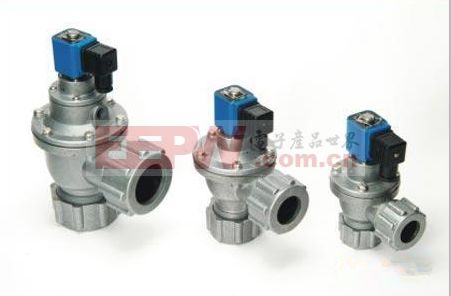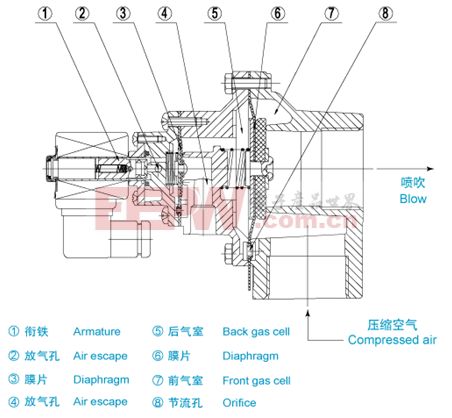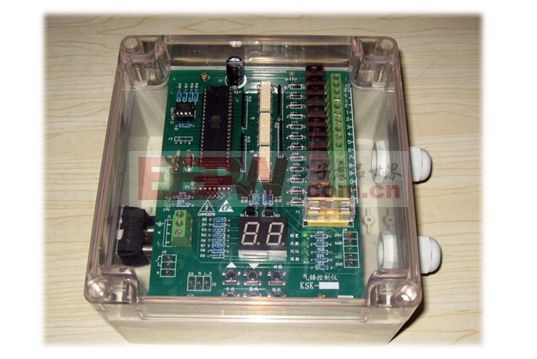Guide: The principle of the pulse solenoid valve is like the kind of faucet that will automatically save water. When you press it, the water will come out. After a while, the water will automatically close. It is very interesting to have wood. Come in and learn more about it. The working principle of pulse solenoid valve ~~~
1. Working principle of pulse solenoid valve --Introduction
Pulse solenoid valve, also known as diaphragm valve, is an automatic basic component used to control fluids. It is an actuator; it is not limited to hydraulic and pneumatic. The solenoid valve is used to control the direction of hydraulic flow. The mechanical mechanism of the factory is generally controlled by hydraulic steel. A solenoid valve will be used. The compressed air "switch" of the pulse bag type dust collector cleaning system is controlled by the output signal of the pulse blowing controller, and the filter bag is sprayed and cleaned row by row, so that the resistance of the dust collector is kept within the set range. Inside, to ensure the dust collector's processing capacity and dust collection efficiency.

2. The working principle of pulse solenoid valve - structure
The pulse solenoid valve is composed of an excitation coil and a magnetic steel to form a pilot valve, and the main valve adopts a special rubber diaphragm structure. Due to its unique design, the valve has the advantages of low power consumption, short transient energization time and wide operating pressure range. It is an ideal actuator for automatic tap water control.
Because the pulse solenoid valve has the characteristics of low power consumption and low voltage, it can be used with the smart card type water meter. It is an indispensable actuator for the automatic control of water and liquid in the intelligent water meter system.

3. Pulse solenoid valve working principle
The working principle of the pulse solenoid valve is to use the pulse of the electric appliance to convert into the mechanical pulsation so that the powerful energy of the pulsating gas becomes a momentum to release a large impulse in a short time, and the interval between the pulses controlled by plc should be determined according to the rated gas pressure recovery time. .
There are closed chambers in the solenoid valve. There are through holes in different positions. Each hole leads to different oil pipes. The middle of the cavity is a valve. On both sides are two electromagnets. Which side of the magnet coil is energized? Which side to attract. When the coil is energized instantaneously, the electromagnetic force moves the armature. When the coil is de-energized, the armature is self-sustained by the permanent magnet force. At this time, the medium pressure of the diaphragm in the main valve chamber passes through the pressure relief hole, so that the diaphragm is pressed up and down. Poor, under the action of the pressure of the inlet medium, hold up the diaphragm, then the main valve opens. When a momentary reverse current is applied to the coil, the armature moves in the opposite direction, the pressure relief hole is cut off, and the medium is plunged into the upper portion of the diaphragm through the balance hole of the main valve to seal the main valve port.
The above is the general principle of the solenoid valve. In fact, the working principle of the solenoid valve is different depending on the temperature, pressure, etc. flowing through the medium. For example, in the self-flow state, zero pressure start is required, that is, after energization, the whole coil of the coil sucks up; when there is a solenoid valve in a pressure state, the coil is energized and then sucks a pin inserted on the gate body, using the fluid itself. The pressure puts the gate up.
The difference between the two methods is that the self-flowing solenoid valve, because the coil has to suck up the entire gate body, so the solenoid valve with a large volume and pressure state only needs to suck the pin, so the volume can be compared. small.

Expand reading:
1. Solenoid valve control circuit
2. Introduction, classification and selection of solenoid valves
3. The working principle of the refrigerator solenoid valve
Pulse igniterOther capacitors
Other Capacitors,Ac Filter Capacitor,Power Saver Capacitor,Line Filter Capacitor,Low Voltage Capacitor
YANGZHOU POSITIONING TECH CO., LTD. , https://www.cndingweitech.com